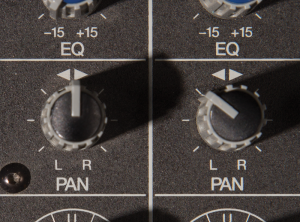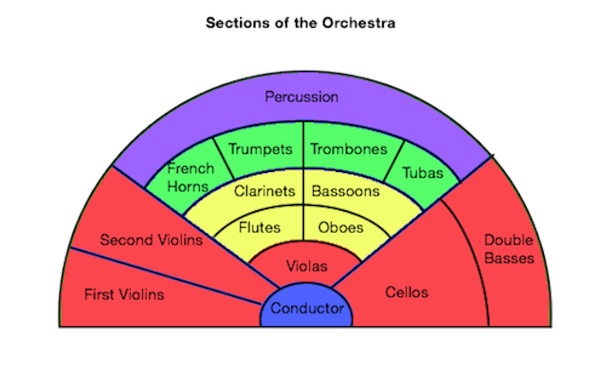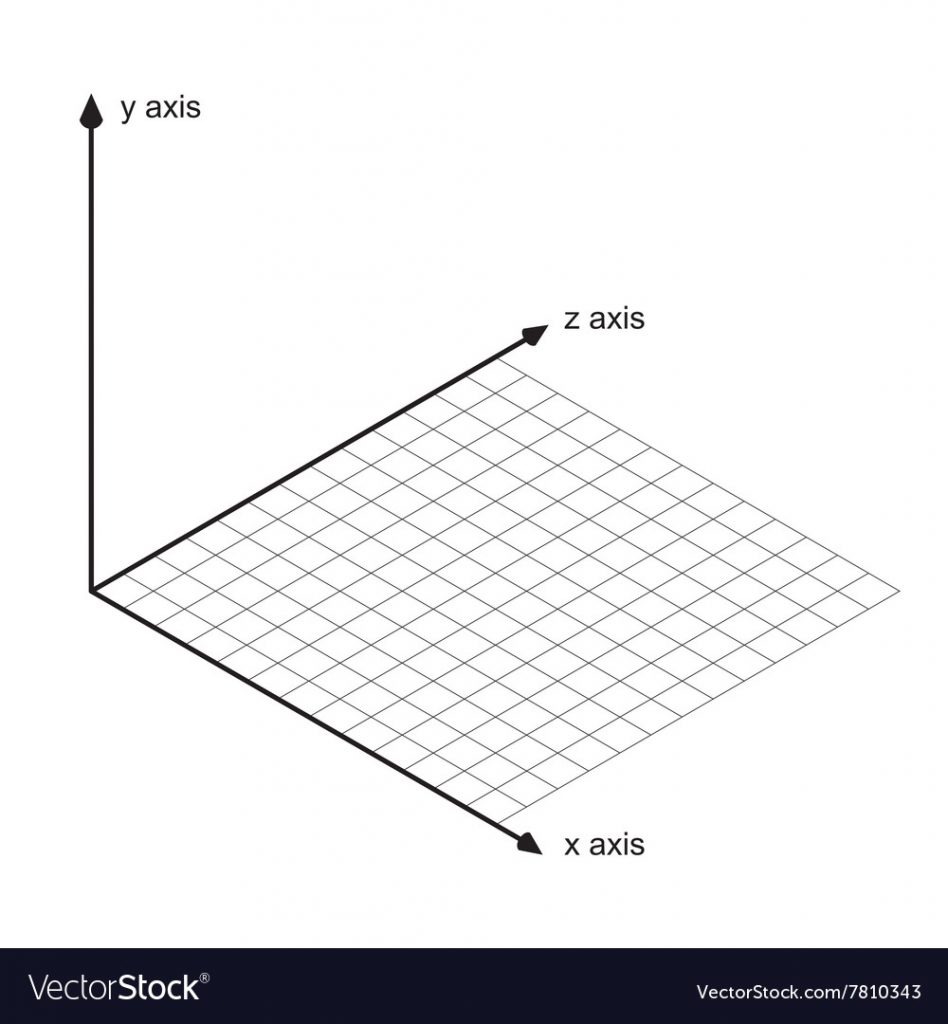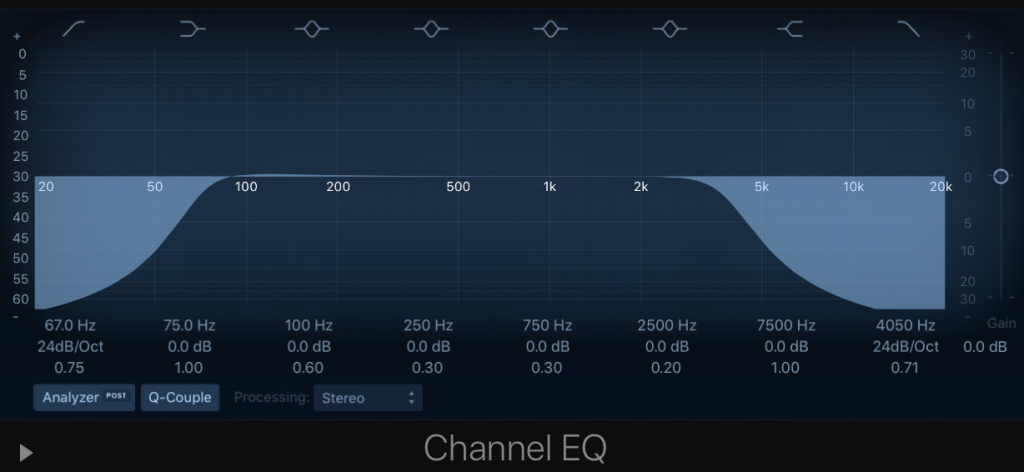In our first post about reverb, we covered the basics: what is reverb, the different kinds of digital reverbs and their various features, and how to use reverb in a musical production. In this new post, we will pick things up from there, and take a deeper look into the use of reverb for more complex mixing concepts such as depth and placement within a three dimensional (3D) space. Our goal in this post is to learn how to use reverb to create mixes with depth.
How to create Mixes with Depth? What is Mix Depth?
As music producers, we have likely used the left (L) and right (R) pan controls on our mixers often:

These tools allow us to move sound from the left to the right sides of the stereo field. But, in “real” life, we hear sounds from more than just the left and right dimensions. For example, we might hear a sound as being closer to us, while another sound seems farther away. These sounds could be coming from the left, or the right, or the center of the stereo field, but, what we are concerned with here in this topic is the sound’s depth: where they sit in the 3D space as a distance from the listener. Is the sound closer to the listener or far from the listener? Understanding this is the first step to creating mixes with depth!
For example, please refer to the graphic below that shows a common orchestra layout. This shows where each instrument sits on the stage from left to right AND from front to back. The conductor is smack in the middle with her/his back to the audience. The first violins are are on the far left and, along with the cellos and double bases (on the right), make up the the instruments that are closest to the audience. Meanwhile, the percussion covers a good section of the center field way in the back of the stage, so it is therefore the farthest away from the audience. The rest of the players fill out positions in the middle (both the stereo left->right, AND the depth front->back.) True 3D sound space!

Life in 3D Sound
While x and y have traditionally referred to the horizontal (up/down) and vertical (left/right) placement of a sound or visual, we use “z” when speaking about the depth, or “front-to-back” placement of a sound or visual. (In fact, we often call it the “z-depth”.) Therefore, you might hear the term “z” or “z-depth” when someone is talking about the depth of a sound or a visual element. They are referring to where a sound sits on this z axis.

But there’s no Mix Depth Control in my DAW?
As you can see now, to create mixes with depth, we need to be concerned not only with the left and right, but, also the front and the back. So, you might be asking yourself, “hey, how do I turn on the depth control in Logic Pro X?” Unfortunately, at least to my knowledge, our recording software and systems, do not include a mix depth control equivalent to the pan knobs. Instead, we have to create the sense of depth ourselves. And…..this is where reverb comes in!
Mix Depth In Action
If you are a user of Spitfire sample libraries, you have probably used their simple microphone mixer / stage tool which is a great way to visualize this depth concept. As you can see in the screenshot from Albion One below, there is a graphic of an orchestra layout (similar to the one I put above.) To the right of this graphic is a slider with 2 labels: Close and Far. Moving the slider up brings the audience closer to the orchestra, while moving the slider down will move the audience further away. Behind the scenes, Spitfire is (likely)adjusting microphone positions: turning up/down the microphones that are either closer or further away from the orchestra, etc. In doing so, we hear either more reverb from the room (far position) or, less reverb and more instrument (close position.)
So, now we see how reverb comes in to help control the depth of a sound.

Of course, this graphic shows the entire orchestra moving together as a giant unit – which, when using ensemble samples, is the case because we can’t separate-out each individual instrument (learn more about ensemble samples in my Part II of this series, here). However, imagine following this practice with each individual instrument patch: (1) load up the first violins only and move the slider to “Close.” Then (2) load up a percussion patch and move the slider to “Far”. Now, you’ve just started to recreate the orchestra layout above by moving the first violins up to the front and placing the percussion in the back.
**It is my understanding that Spitfire records each instrument in their ideal orchestral position. This means that when you load up all the different patches for each instrument: violins, cello, woodwinds, percussion, etc, Spitfire has already “placed” them at their depth based on how the orchestra was set up: violins up front, percussion in the back (as in the orchestra layout above.) Therefore, if you’re using all Spitfire instruments from a specific library (Eg all Albion) you likely don’t need to tweak these mic positions to much in order to create a sense of depth, because, that depth is already baked into the samples as recorded. However, understanding these concepts is the key point here (which is why I like using the Spitfire interface tool as an example) and, I have found that even when using a single Spitfire library in this way, I still need to use these techniques to create more depth within my mix. In other words, I will still go in and push the percussion back and bring the violins forward.
So, if you don’t use a sample library like Spitfire that includes this control, or, if you need to blend your instruments with another reverb to make them sound “together, in the same room” (see part 1 of this post here), then, you can use reverb to help control each sound’s depth (z position) as it’s effectively doing the same thing as the Spitfire’s microphone mixer to move your sounds close or farther away from the listener. As I refer above, this is what I end up doing regardless as I find I need to create even more depth and space between instruments.
How to use Reverb to Create mixes with Depth
If the concepts above are making sense, you can now use reverb to create a sense of depth, for any instrument ensemble. While perhaps more pronounced and traditional for an orchestra, these concepts work the same for a rock band, jazz ensemble, choir, sound design, atmospheres, etc. In a simple nutshell: more reverb means the sound is pushed farther away, less reverb means the sound comes closer. So, along with our trusty left (L) and right (R) panning knobs, we can now use reverb to complete the design of a complete 3D sound space!
Wow, I typed a lot of stuff above, just to come to that short, simple conclusion!
But what…..there’s more…..
Don’t Forget the EQ
Just when I thought I was becoming a master at this stuff, I learned that I was missing one powerful tool to use with reverb to help control the depth of a sound: EQ. Imagine a tuba blowing a loud note 5 feet in front of you. Now, move that tuba 30 feet away. Not only will you hear more of the room response (the reverb), but, that tuba will not sound as full and bold as it did when it was close to you. This is because as a sound moves farther away from the listener, it will start to loose body (low end) and air/detail (high end.) If you simply add or remove reverb to an instrument, you’re not really recreating the true sound it would have if it was closer or further from you. Remember too: the sound of the instrument changes first (as we describe here), and then the reverb is added to that new sound.
Referring back to the Spitfire stage tool mentioned above, what is important to remember is that they aren’t just turning reverb up or down depending on how close the orchestra is to the listener; they are controlling the volume of the different microphones that captured the sound of the instruments in that room. So, a microphone placed far back in the room, will hear the sound of a tuba as it really sounds to a listener who was sitting that far away: with less low end and less high end, verses the microphone that was placed up close on that same tuba.
If we want to create a similar effect using our own tools and reverb, then, we can use EQ to help simulate this impact of distance on a sound. This is done by lowering both the low end, and the high end of a sound as you want to move it back in the mix. The more drastic the cuts, the more the sound will loose it’s body and detail and sound further “back” in the mix. Of course, ideally you will be mirroring this by increasing the reverb that’s being added. So, the EQ and the reverb are working together in this way.
Below is a screenshot of how this might look using the Logic Pro EQ.

What Comes first the EQ or the Reverb?
One of the biggest questions when using this technique is the signal chain: do we add the reverb first and then the EQ? Or vice versa? I believe this gets a little more complicated because of the various routing options available in various DAW mixers and producer approaches. For example, if you set up a single reverb on an Aux channel, and then SEND the instrument signal to this Aux channel. Are you sending the signal pre or post fader? Do you have a single reverb that all the instruments route to in this way, etc….
While it might get confusing in practice, let’s first agree on the the concept. As I (once again) reference the Spitfire microphone mixer/stage tool, let’s remember that the microphones are picking up the sound, (close or far) in the room as the sound is made. And, this sound comes first and the reverb is created FROM that sound. Therefore, a thinner sound will have a different reverb sound than a fuller sound. So, in my opinion, to better recreate this effect, we want to EQ the sound first and then add the reverb (however you choose to use the routing and options within your own DAW.)
One common approach is to create a separate reverb Aux channel for each section of the orchestra: violins, violas, cello, bass, woodwinds, brass, percussion. Each Aux then has its own reverb and EQ to create the “depth” and therefore, creating a position for that group within the 3D sound space. For example, the reverb for the percussion might be larger and its EQ cuts more dramatic in order to move the percussion further back. Meanwhile, the Aux for the first violin will have a smaller reverb and the EQ cuts will be minimal as we need to “hear” this instrument up closer.
On the surface, this is a great approach, and one that I use myself, but with one major caveat/checkpoint: I make sure I’m not ruining this effect by letting too much of the original, non-EQ’d original sound sneak into the mix. For example, if you SEND signal from the percussion channel to this new aux channel to do the work of creating a sense of depth via reverb and EQ as we described here, be sure that you are not also letting the original, un-processed sound of the percussion leak out either via it’s channel fader or some other effects/routing. This is super common when starting out, and will ruin the sense of depth as you’ve now brought back the “up close” sound of the percussion to compete with the “far away” sound. In some cases, this might be needed in order to introduce more clarity to an instrument that has been pushed back in the mix (although, I’d argue: why not do this via the Aux track by decreasing the reverb or lessening the EQ cuts?)
No More Solo Button!
The success of this approach can require us to truly alter the original source sound. In the case of pushing a sound far back in the mix, we might need to make serious cuts to the low and the high end, which, if heard on its own, out of the context of the full mix, could sound thin and maybe even muffled. This can seem surprising and crazy for some producers at first, as we all strive to make our sounds the best they can be. And, this is another reason to never use the solo button when mixing! (That’s for another post!)
Thanks again for stopping by and reading all this fun stuff! I hope you were able to take away some good concepts and techniques for how to use reverb to create mixes with depth. Mixes are not just the left(L) and right (R) – don’t forget the “Z”!